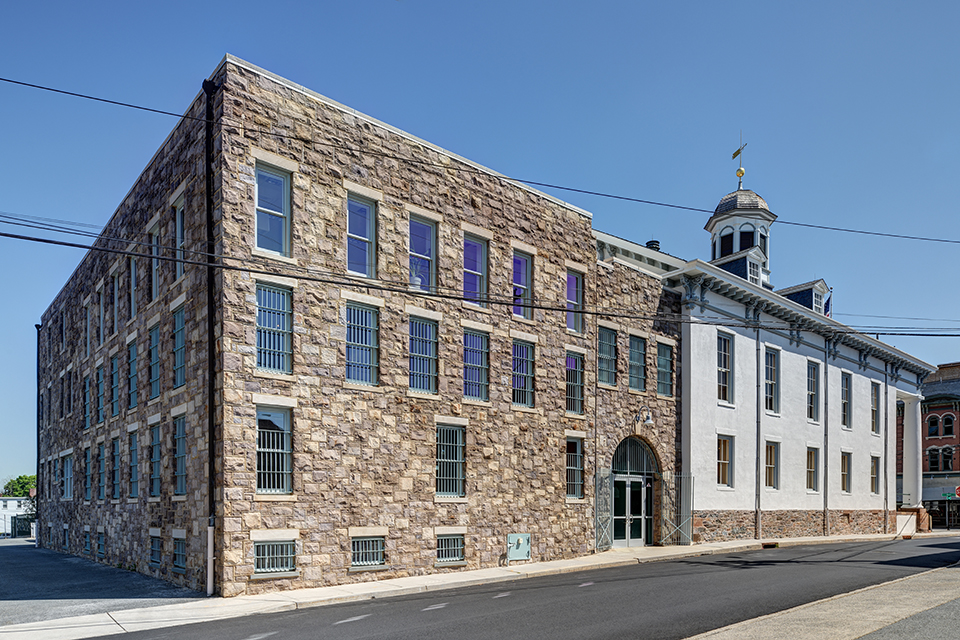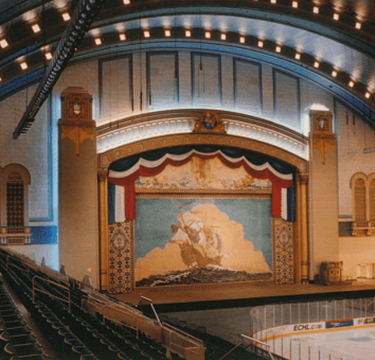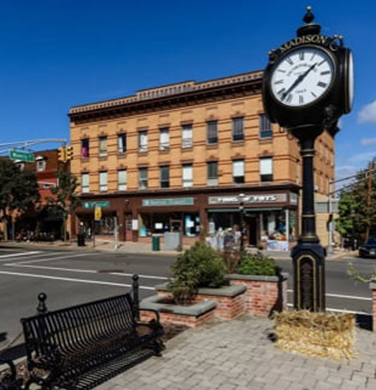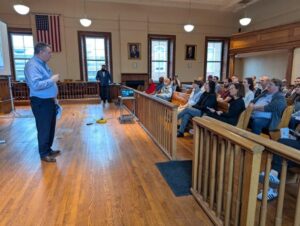
Audience is engaged, as project architects James Giresi and Michael Hanrahan begin to discuss the Hunterdon County Court House restoration.
On Saturday, June 16th, Michael Hanrahan, FAIA, partner, and James Giresi, AIA, senior associate of Clarke Caton Hintz, gave a lecture and tour of the recently restored historic Hunterdon County Courthouse and Jail. Hosted by Preservation New Jersey and AIA Central New Jersey, the lecture explored the long history of the Greek Revival structure, most notably as the backdrop for the “Trial of the Century.”
Hunterdon County’s Courthouse is best known as the site of the infamous 1935 Lindbergh kidnapping trial. Constructed in 1828, it holds statewide significance as one of the oldest surviving county courthouses in New Jersey and is a distinguished example of temple-form Greek Revival architecture. According to the 1996 Preservation Plan prepared by Ford Farewell Mills and Gatsch, it may be the earliest Greek Revival temple-form building in the state. The Jail, constructed in 1925, is one of several county jails built during the early 20th century in response to a broader prison reform movement. Its design represents state-of-the-art correctional architecture for its time.
Although Hunterdon County was established in 1714, the first courthouse was built in 1791, replacing a facility previously located in Trenton, now the capital of Mercer County. That first courthouse was destroyed by fire in 1828 and was quickly replaced by the current structure. The historic jailhouse, constructed in 1925, remained in use until 1985, when a new county jail was completed. The courthouse itself remained in operation until 1996, when the new justice center opened.
Tour participants explore the historic jail cells at the Hunterdon County Courthouse.
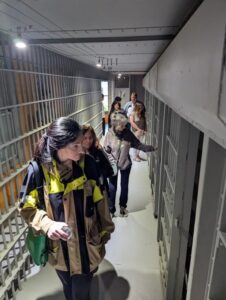
Tour participants explore the historic jail cells at the Hunterdon County Courthouse.
The building is an impressive Greek Revival structure, featuring large Doric columns raised
above the street and accessed via a flight of brownstone steps. The interior, particularly the courtroom, was remodeled in 1880, featuring an elaborate tin ceiling, new lighting, and a reconfigured seating layout and dais. After the Lindbergh trial of 1934–1935, the courtroom and interior underwent another renovation, intended to erase the dark legacy of the trial and “restore” the space to its earlier appearance. However, this work was not a true restoration; it was conjectural and reflected a 1950s Colonial Revival aesthetic.
The Historic Hunterdon County Courthouse and Jail are located within the Flemington Historic District. The Courthouse satisfies Criteria A, B, and C of the National Register Criteria for Evaluation and is a high preservation priority. The Jail qualifies under Criteria A and C, but is most important for the cell which housed Bruno Hauptmann and its façade along Court Street. While the Courthouse has undergone renovations over the years, the integrity of the building fabric is basically intact. The most important dates in the building’s history are 1828 (original construction) and 1935 (Lindbergh trial). Of the two dates, 1935 offered the greatest potential as a target date for restoration. Extensive documentation from that period was utilized to fully restore the exterior and the courtroom.
James Giresi, AIA discusses the preservation efforts of the historic Hunterdon County Courthouse during the presentation portion of the program.

James Giresi, AIA discusses the preservation efforts of the historic Hunterdon County Courthouse during the presentation portion of the program.
In 2000, the courthouse exterior was restored, in part with funding from the New Jersey Historic Trust. In 2006, Clarke Caton Hintz led the restoration of the courthouse interior. The main courtroom was carefully returned to its 1934–1935 appearance using extensive photographic documentation. The jailhouse was also rehabilitated both inside and out, with its cells restored as exhibit areas. The link between the courthouse and jail was redesigned to include handicapped access, including an elevator serving both structures. In 2024, Clarke Caton Hintz completed the most recent phase of restoration, repairing damaged stucco, deteriorated mortar, and rotted wood to ensure long-term preservation of the interior.
The trial of Bruno Hauptmann for the kidnapping of Charles Lindbergh’s young son has long been referred to as “the trial of the century.” It attracted nationwide attention, with spectators flocking to the courthouse and jail. In October 1934, The New York Times reported that the courthouse drew hundreds of curious onlookers. During the trial, Flemington and the courthouse remained in the national spotlight. Artifacts from that era are still on display today, including the witness chair from the trial and hand-carved jury chairs. The courthouse has hosted reenactments of the 1934–1935 trial and continues to be used for public presentations and meetings.
This restoration serves as a testament to the enduring significance of the courthouse and jail as both civic monuments and living museums. The project underscores the importance of thoughtful, research-driven preservation that honors historic integrity while adapting to present-day needs. The restored facilities not only safeguard irreplaceable architectural details but also provide the public with access to spaces that continue to foster education, civic pride, and historical understanding. As a result, the Hunterdon County Courthouse and Jail remain vital landmarks in the cultural and architectural heritage of downtown Flemington, Hunterdon County and more broadly New Jersey and the nation.
